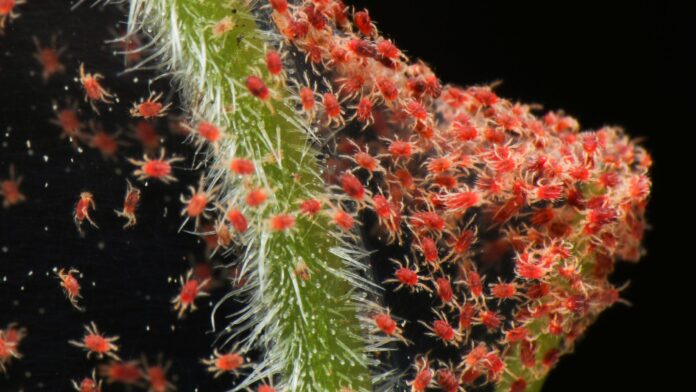Spider mites may be tiny, but their impact on plants can be devastating if not addressed promptly. Whether you’re tending to a home garden or nurturing indoor plants, understanding these pests—from their life cycle to effective management strategies—is crucial for maintaining plant health.
In this guide, we’ll delve into everything you need to know about spider mites: their life cycle, early detection signs, differences in indoor and outdoor control methods, and proven strategies to eliminate them.
🕷️ What Are Spider Mites?
Spider mites are microscopic arachnids, typically less than 1mm in size, belonging to the family Tetranychidae. They thrive on the undersides of plant leaves, feeding on plant cells by puncturing them and extracting the contents. This feeding behavior can lead to significant plant damage, including discoloration, leaf drop, and even plant death in severe cases.
Common species include:
- Two-spotted spider mite (Tetranychus urticae) – the most prevalent and notorious for infesting a wide range of plants.
- Red spider mite (Tetranychus cinnabarinus) – often found in warmer climates.
- Carmine spider mite (Tetranychus cinnabarinus) – similar in appearance to the red spider mite and equally destructive.
🧬 Spider Mite Life Cycle
Understanding the life cycle of spider mites is essential for effective control, as their rapid reproduction can lead to swift infestations.
| Stage | Duration | Key Characteristics |
|---|---|---|
| Egg | 2–4 days | Laid on leaf undersides; spherical and initially transparent. |
| Larva | 1–2 days | Six-legged; begins feeding immediately upon hatching. |
| Nymph | 3–7 days | Undergoes two stages: protonymph and deutonymph; eight-legged and actively feeding. |
| Adult | 2–4 weeks | Capable of laying hundreds of eggs over their lifespan. |
Under optimal conditions, such as temperatures around 27°C (80°F) and low humidity, spider mites can complete their life cycle in as little as a week, leading to rapid population explosions. Wikipedia
🔍 How to Identify a Spider Mite Infestation
Early detection is critical to prevent widespread damage. Here are signs to watch for:
Early Indicators:
- Speckled or Stippled Leaves: Tiny white, yellow, or bronze spots on leaves, resulting from cell damage.
- Fine Webbing: Delicate silk webs on leaf undersides and between stems, providing mites with protection and aiding in dispersal.
- Leaf Yellowing and Drop: As feeding progresses, leaves may turn yellow, dry out, and eventually fall off.
- Overall Plant Decline: Stunted growth and reduced vigor, making plants more susceptible to other stresses.
Pro Tip: Regularly inspect the undersides of leaves using a magnifying glass to catch infestations early.
🌿 Indoor Spider Mite Management
Indoor environments can inadvertently favor spider mite proliferation due to stable temperatures and lower humidity. Effective management involves a combination of cultural practices and targeted treatments.
Step-by-Step Control:
- Isolate Affected Plants:
- Immediately separate infested plants to prevent mites from spreading to healthy ones.koppertus.com+5Real Simple+5koppertus.com+5
- Clean Plant Surfaces:
- Gently wipe leaves with a damp cloth or spray with lukewarm water to remove mites and their webs.
- Increase Humidity:
- Spider mites thrive in dry conditions. Boost humidity by misting plants, using humidifiers, or placing water trays nearby.
- Apply Miticides or Natural Oils:
- Use insecticidal soaps, neem oil, or horticultural oils, ensuring thorough coverage of all plant surfaces. Repeat applications as necessary, following product guidelines.
- Introduce Beneficial Predators:
- In controlled environments like greenhouses, releasing predatory mites such as Phytoseiulus persimilis can effectively reduce spider mite populations.
- Monitor and Repeat:
- Regularly check plants for signs of mites and continue treatments until the infestation is under control.
🌱 Outdoor Spider Mite Management
Outdoor plants are subject to natural predators and environmental factors that can influence spider mite populations. However, during hot and dry periods, infestations can escalate.
Best Practices:
- Water Sprays:
- Use a strong jet of water to dislodge mites from plants, focusing on the undersides of leaves. This method also helps increase local humidity.
- Encourage Natural Predators:
- Promote a habitat for beneficial insects like ladybugs, lacewings, and predatory mites, which naturally keep spider mite numbers in check.
- Selective Use of Miticides:
- If chemical intervention is necessary, choose miticides that are less harmful to beneficial insects and rotate active ingredients to prevent resistance. Always adhere to application guidelines.koppertus.com
- Maintain Plant Health:
- Ensure plants are well-watered and fertilized appropriately, as healthy plants are more resilient to pest infestations.
🌎 Biological Control: Utilizing Predatory Mites
Biological control involves using natural enemies to manage pest populations. Predatory mites are effective allies in the fight against spider mites.
Key Predatory Mite Species:
- Phytoseiulus persimilis:
- Specializes in preying on various stages of spider mites and is effective in both greenhouse and outdoor settings. Wikipedia
- Neoseiulus californicus:
- A generalist predator that feeds on spider mites and can tolerate a range of environmental conditions, making it suitable for various crops. koppertus.com
Implementing Biological Control:
- Assess Pest Levels:
- Determine the severity of the infestation to decide on the number of predatory mites needed.koppertus.com
- Release Predatory Mites:
- Release Predatory Mites:
- Gently distribute predators across infested plants, focusing on leaf undersides.
- Use carrier materials like bran or vermiculite to aid dispersal.
- Environmental Support:
- Maintain relative humidity between 60–80% and temperatures between 20–30°C (68–86°F) for best predator performance.
- Avoid using broad-spectrum insecticides, which may harm beneficial mites.
- Monitor Success:
- Check weekly for reduced mite damage and predator presence. Reintroduce predators if needed for larger infestations.
📉 How to Prevent Spider Mite Infestations
Prevention is always better than cure. Here are the best practices:
- Inspect New Plants: Always quarantine and examine plants before introducing them to your space.
- Maintain Cleanliness: Remove fallen leaves and dust, both indoors and outdoors.
- Avoid Overfertilizing: Excess nitrogen makes leaves more attractive to mites.
- Encourage Biodiversity: A healthy ecosystem with diverse plantings supports natural pest control.
- Use Mulch Wisely: Mulch helps retain soil moisture and can reduce dust around the plant base.
🎥 Video Resource: Identifying and Managing Spider Mites
❓ FAQ: Everything You Want to Know About Spider Mites
Q: Can spider mites harm humans or pets?
A: No, spider mites don’t bite or carry disease. They only damage plants.
Q: Do spider mites fly?
A: No. They crawl from plant to plant or hitch rides on people, pets, or wind-blown webs.
Q: Can I get rid of spider mites without chemicals?
A: Yes — frequent washing, neem oil, predatory mites, and increased humidity work well.
Q: What temperature do spider mites thrive in?
A: 70–85°F (21–29°C) is ideal. Hot, dry conditions lead to explosive population growth.
Q: How long does it take to fully eliminate them?
A: Expect 2–3 weeks of consistent treatment to break the life cycle.
Q: Will cold weather kill spider mites outdoors?
A: Most outdoor mites die off in freezing weather, but eggs may overwinter under bark or leaf litter.
Q: Are spider mites more common in certain plants?
A: Yes — they love tomatoes, cucumbers, peppers, roses, houseplants like fiddle leaf figs, and cannabis.
Q: Is it safe to eat food from a plant that had spider mites?
A: Yes, just wash thoroughly. Mites themselves are harmless to humans.
Q: Are spider mites spiders or mites?
A: So while they’re not true spiders, spider mites are part of the arachnid class, which includes spiders, ticks, and scorpions. The “spider” in their name comes from their ability to spin fine silk webs, which helps protect them and their eggs — much like spiders do.
Quick Facts:
✅ They’re more closely related to ticks than to true spiders.
❌ They don’t spin elaborate webs like spiders.
❌ They don’t bite humans or prey on insects.
✅ They feed on plant cells, piercing the leaf surface and sucking out the contents.
This article was brought to you by the Know the Natives Plant Guide.
If you’ve made it this far, chances are this book is right up your alley.
Every purchase helps support the creation of more free plant guides, how-tos, and gardening tips like this one.









